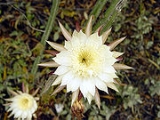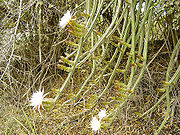
Selenicereus spinulosus
Encyclopedia
Selenicereus spinulosus is a cactus
species
native to eastern Mexico
and, possibly, the lower Rio Grande Valley
of Texas
in the United States
. Common names include Spiny Moon Cereus and Vine-like Moonlight Cactus. Its specific name, spinulosus, means "spiny" in Latin
and is unusual for a plant with relatively short spines.
from Tamaulipas
to Chiapas
. Plants were collected from the lower Rio Grande Valley
of Texas
in the United States
, but this population may have been extirpated
as it has not been seen outside of cultivation in some time.

, white or yellowish, later blackish, radial spines 5-6 central spines 1-2 , basally 0,25 mm in Ø above the swollen bases, apically attenuate-conical, circular in cross section, the bulbous bases 0,5 mm in Ø, hairlike spines none; epidermis light green, somewhat shining. Flowers produced from areole
s near tip, 8–14 cm long, 7-8,5 cm in Ø, nocturnal but stays open for 2 2–3 days (John Ellis, UK), tepals rotate; pericarpel covered with spines, but no hairs, bracteoles small, triangular, reddish; receptacle ca 5 cm long, green, with clusters of 7-12 spines, 4–5 mm long, brownish, but no hairs; outer tepals 5,5–6 cm, narrowly oblong, acute, brownish; inner tepals 7,5 cm, 11 mm wide, narrowly oblong, acute, white, sometimes with pink base or pinkish throughout; stamens white, much shorter than inner tepals; style yellow, stigma lobes 9-11. Fruit globular, yellow, covered densely with yellowish spines.
Cactus
A cactus is a member of the plant family Cactaceae. Their distinctive appearance is a result of adaptations to conserve water in dry and/or hot environments. In most species, the stem has evolved to become photosynthetic and succulent, while the leaves have evolved into spines...
species
Species
In biology, a species is one of the basic units of biological classification and a taxonomic rank. A species is often defined as a group of organisms capable of interbreeding and producing fertile offspring. While in many cases this definition is adequate, more precise or differing measures are...
native to eastern Mexico
Mexico
The United Mexican States , commonly known as Mexico , is a federal constitutional republic in North America. It is bordered on the north by the United States; on the south and west by the Pacific Ocean; on the southeast by Guatemala, Belize, and the Caribbean Sea; and on the east by the Gulf of...
and, possibly, the lower Rio Grande Valley
Rio Grande Valley
The Rio Grande Valley or the Lower Rio Grande Valley, informally called The Valley, is an area located in the southernmost tip of South Texas...
of Texas
Texas
Texas is the second largest U.S. state by both area and population, and the largest state by area in the contiguous United States.The name, based on the Caddo word "Tejas" meaning "friends" or "allies", was applied by the Spanish to the Caddo themselves and to the region of their settlement in...
in the United States
United States
The United States of America is a federal constitutional republic comprising fifty states and a federal district...
. Common names include Spiny Moon Cereus and Vine-like Moonlight Cactus. Its specific name, spinulosus, means "spiny" in Latin
Latin
Latin is an Italic language originally spoken in Latium and Ancient Rome. It, along with most European languages, is a descendant of the ancient Proto-Indo-European language. Although it is considered a dead language, a number of scholars and members of the Christian clergy speak it fluently, and...
and is unusual for a plant with relatively short spines.
History
This was the third species of Selenicereus to be discovered. It was originally collected by Thomas Coulter in 1827, in Mexico, but no locality is known. Pyramus de Candolle received the plant in Paris and descripted it without knowing its flowers. He later sent cuttings to Berlin where it flowered the first time in 1842.Range and habitat
This species is found in eastern MexicoMexico
The United Mexican States , commonly known as Mexico , is a federal constitutional republic in North America. It is bordered on the north by the United States; on the south and west by the Pacific Ocean; on the southeast by Guatemala, Belize, and the Caribbean Sea; and on the east by the Gulf of...
from Tamaulipas
Tamaulipas
Tamaulipas officially Estado Libre y Soberano de Tamaulipas is one of the 31 states which, with the Federal District, comprise the 32 Federal Entities of Mexico. It is divided in 43 municipalities and its capital city is Ciudad Victoria. The capital city was named after Guadalupe Victoria, the...
to Chiapas
Chiapas
Chiapas officially Estado Libre y Soberano de Chiapas is one of the 31 states that, with the Federal District, comprise the 32 Federal Entities of Mexico. It is divided in 118 municipalities and its capital city is Tuxtla Gutierrez. Other important cites in Chiapas include San Cristóbal de las...
. Plants were collected from the lower Rio Grande Valley
Rio Grande Valley
The Rio Grande Valley or the Lower Rio Grande Valley, informally called The Valley, is an area located in the southernmost tip of South Texas...
of Texas
Texas
Texas is the second largest U.S. state by both area and population, and the largest state by area in the contiguous United States.The name, based on the Caddo word "Tejas" meaning "friends" or "allies", was applied by the Spanish to the Caddo themselves and to the region of their settlement in...
in the United States
United States
The United States of America is a federal constitutional republic comprising fifty states and a federal district...
, but this population may have been extirpated
Local extinction
Local extinction, also known as extirpation, is the condition of a species which ceases to exist in the chosen geographic area of study, though it still exists elsewhere...
as it has not been seen outside of cultivation in some time.
Systematics
Selenicereus spinulosus is a very variable species, especially in flower size, which vary from 7–15 cm long. It is most closely related to Selenicereus atropilosus and Selenicereus vagans.
Description
Stems scandent, clambering or sprawling, branching, producing aerial roots, stiff, to 1-2(-5) m long, 2–3 cm thick; ribs 4-6 or more, later terete, acute; areoles 1,5–2 mm on Ø, reddish brown at first, later greyish brown, internodes 1,5-2,5 cm; spines 6-8, 1 mm long, acicularLeaf shape
In botany, leaf shape is characterised with the following terms :* Acicular : Slender and pointed, needle-like* Acuminate : Tapering to a long point...
, white or yellowish, later blackish, radial spines 5-6 central spines 1-2 , basally 0,25 mm in Ø above the swollen bases, apically attenuate-conical, circular in cross section, the bulbous bases 0,5 mm in Ø, hairlike spines none; epidermis light green, somewhat shining. Flowers produced from areole
Areole
Areoles are an important diagnostic feature of cacti, and identify them as a family distinct from other succulent plants. The areoles on cacti are clearly visible; they generally appear as small light- to dark-colored bumps, out of which grow clusters of spines...
s near tip, 8–14 cm long, 7-8,5 cm in Ø, nocturnal but stays open for 2 2–3 days (John Ellis, UK), tepals rotate; pericarpel covered with spines, but no hairs, bracteoles small, triangular, reddish; receptacle ca 5 cm long, green, with clusters of 7-12 spines, 4–5 mm long, brownish, but no hairs; outer tepals 5,5–6 cm, narrowly oblong, acute, brownish; inner tepals 7,5 cm, 11 mm wide, narrowly oblong, acute, white, sometimes with pink base or pinkish throughout; stamens white, much shorter than inner tepals; style yellow, stigma lobes 9-11. Fruit globular, yellow, covered densely with yellowish spines.
Cultivation
Plants ca 1 m long are capable of flowering. Give half-shade or full sun, and grow in a compost containing plenty of peat. During the growing period this plant needs ample water and regular doses of fertilizer. Fast growing and free flowering. Can be kept at 5°C (41°F) during winter, if kept dry. It is the easiest species to bring to flower in cultivation.Hybrids
- 'Pimiento' (Raised by Sherman E. Beahm in 1955) (S. spinulosus × DisocactusDisocactusDisocactus is genus of epiphytic cacti from Mexico to South America. It should not be confused with Discocactus, which is another genus.-Synonymy:*Aporocactus Lem.*Aporocereus Fric & Kreuz....
'Tulip') Wide open flower of Capsicum red darkening towards the edges. Medium. - 'Sacred Ox' (Dr. Robert Poindexter 1943) (S. spinulosus × 'Scarlet Giant') Tepals white with pink and yellow outer tepals.
- 'Twinkle' (Dr. Robert Poindexter) (S. spinulosus × 'Scarlet Giant') Open wide bloom of salmon orange. Very similar to 'Gloria'.
- 'Tululosa' (Beamh 1947) (S. spinulosus × Disocactus 'Tulip'). Straw-orange edged in lavender. Nocturnal.

